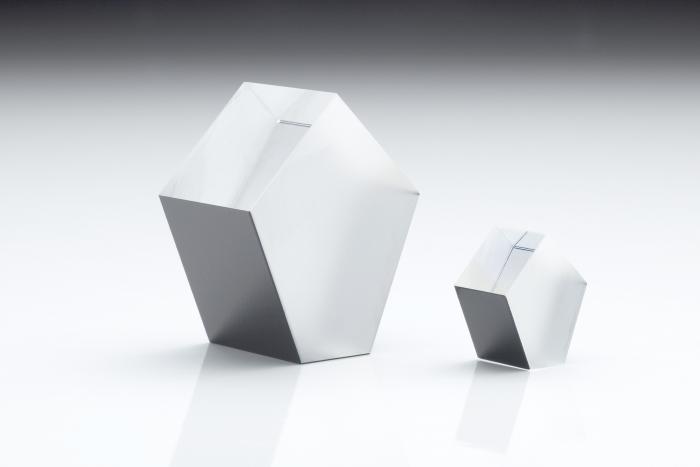
From the optical path, it is obvious that the angle of 45 ° angle needs to be carefully controlled in order to meet the requirements of angle accuracy. At the same time, an exit surface with an angle of 90 ° is polished to ensure the first parallel difference, and the accuracy of the 90 ° angle between the incident light and the exit light meets the requirements of high accuracy. Two issues need to be noted here:
(1) Precautions during strip processing: when processing pentagonal prisms with small size, they are often processed into strips and then cut. Therefore, when selecting materials, special attention should be paid to the consistency of the refractive index of the whole glass, otherwise the accuracy of some prisms will be unqualified due to the change of N;
(2) In general, attention is often paid to the accuracy of 45 ° angle during processing, but for prisms with high requirements for beam wavefront, for example, if attention is not paid to the flatness processing of 45 ° angle surface, the wavefront inspection of outgoing beam is unqualified. At this time, even if the outgoing surface is repaired, it cannot meet the requirements. Therefore, when processing two planes with 45 ° angle, attention should be paid to both angle and flatness.
Measurement of working angle of pentagonal prism
(1) Test system
The working angle of the pentagonal prism, that is, the angle between the incident light and the outgoing light, is about 6 times between the angles < 90 ° and < 45 °. Therefore, when the relationship between the angles is handled well, the working angle of the pentagonal prism can often achieve better accuracy. However, due to the long optical path of light in the pentagonal prism, when the pentagonal prism is large, the consistency of refractive index is very high. At the same time, because the light beam is transmitted, reflected and emitted through multiple surfaces, the flatness and finish of each surface have an impact on the final baud surface. Generally speaking, the requirements for pentagonal prism are quite high. The test system of working angle can be seen in Figure 3.
Install a reflector on the multi tooth splitter, as shown in Fig. 3 (a) and Fig. 3 (b) for the first reading, and turn the multi tooth splitter 180 ° in Fig. 3 (c) for reading. When the reading in Fig. 3 (b) is added and divided by 2, it is the required data. Obviously, this test is to eliminate the eccentricity of the 90 ° angle of the pentagonal prism, so as to obtain the error value of the real 90 ° angle.
(2) Data
In the test system, three kinds of angular errors can be measured: the error of 90 ° angle between incident light and outgoing light, whose reading value comes from the mirror, so it can be read on the photoelectric collimator, that is, the error of working angle of pentagonal prism; When the light beam reflected from the exit surface of the pentagonal prism returns to the photoelectric collimator, the first parallel difference and the second parallel difference can be read out. Because the reflected light is weak, its reflected image is not as bright as that reflected by the mirror, which also distinguishes the two.



